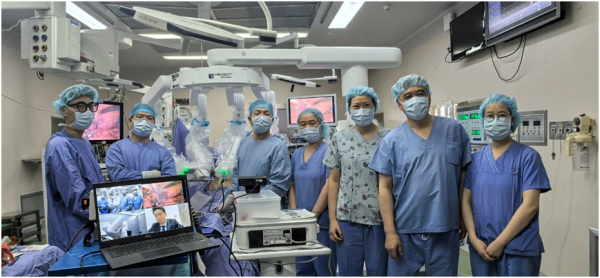
First in the World! Zhejiang University Professor Performs Transcontinental Robotic Surgery
On July 19 (Central European Time), in an operating room of Sir Run Run Shaw Hospital (SRRSH), affiliated with Zhejiang University School of Medicine, 80-year-old Mr. Wu (pseudonym) lay calmly as the steady beeps of the monitor masked an extraordinary feat—his liver, scarred by chronic hepatitis B lasting for two decades and further complicated by open surgery 14 years ago and radiation therapy six months prior, was undergoing a groundbreaking procedure.
Meanwhile, 10,000 kilometers away in Strasbourg, France, during the annual meeting of the Society of Robotic Surgery (SRS), Professor Liang Xiao leaned into the console, deftly maneuvering the control sticks. In response, on the operating table in Hangzhou, four robotic arms—nimble as “steel fingers” that can rotate 360 degrees inside the patient’s abdomen, meticulously separated adhesions while avoiding dense vascular networks. A high-definition camera relayed real-time, magnified visuals of the 3.5 cm tumor to screens in France.
“Hemostasis achieved. Drainage tube placed. Procedure complete.” Professor Liang’s voice commands were transmitted clearly to Hangzhou via an audio system. Across time zones, two teams cooperated to execute every move with precision that can only be seen in textbooks. Fifty minutes later, as the tumor was fully removed, applause erupted in Strasbourg, with exclamations of “Excellent!” echoing throughout the procedure.
The world’s first intercontinental robotic-assisted liver cancer resection has been completed!
Mr. Wu recovered smoothly and was expected to be discharged in 2-3 days.
Beyond Technology: A Test of Precision and Trust Spanning 10,000 km
The patient’s critical condition called for immediate intervention, yet his attending was abroad at an academic conference. To seize the optimal treatment window—and based on unwavering trust—both the patient and the medical team opted for the hospital’s latest cutting-edge transcontinental robotic system for surgery.
The challenges were immense:
Stability: The 10,000-km distance placed stringent demands on the reliability of robots.
Complexity: The liver’s intricate structure and vascular-biliary network already make resection highly challenging, requiring exceptional skills and adaptability from the surgeon.
The two teams in China and France responded to all the uncertainties by meticulous preparation and close teamwork. Preoperatively, the surgical team conducted thorough hepatic function assessments, planned resection margins scientifically, and secured informed consent for remote surgery. Intraoperatively, Professor Liang completed each step—adhesion dissection, tumor identification, resection planning, hemostasis, and wound management—with flawless precision.

The robotic system performed steadily, with stable operation, crystal-clear imaging, and uninterrupted communication. Nearly 20,000 global experts—surgeons, researchers, and regulators attending the annual meeting of SRS—applauded the Chinese-developed robot’s performance and Professor Liang’s brilliant techniques, composure, meticulous surgical plans, and standardized approach.
“I never imagined performing ultra-long-distance surgery across oceans,” said Professor Liang after the operation. This success fuels my confidence in telesurgery, domestic robotics and 5G, and I’m hopeful that our domestic high-tech can provide more access to healthcare.”
Homegrown Innovation: Reshaping Healthcare Equity
As an early introducer of robotic surgery, Sir Run Run Shaw Hospital has spearheaded domestic robotic research and development. In February 2023, its team in Hangzhou collaborated with its Alaer Campus in Xinjiang to complete China’s first 5G-powered remote gallbladder resection using a fully self-developed robotic system, pioneering a “hyper-remote surgery” model. Subsequent milestones—including the world’s first 5G remote left lateral liver resection, right hemihepatectomy, and spleen-preserving pancreatic tumor resection—validated the feasibility of surgery transcending geographical barriers.
Advancements in telesurgery are transforming robots from “tools” into “platforms” and extending minimally invasive techniques to underserved regions. Under President Cai Xiujun’s leadership, Sir Run Run Shaw Hospital has:
Institutionalized remote robotic surgeries across multiple campuses;
Launched China’s first Expert Consensus on 5G Remote Robotic Hepatobiliary-Pancreatic Surgery (2025);
Partnered with grassroots hospitals in Xinjiang, Zhejiang’s Jiangshan, and beyond for “multi-scenario” telemedicine (e.g., robotic operations, joint e-consultations, AI-assisted ultrasounds), bridging healthcare gaps between urban and out-of-the-way rural areas.

Soon, patients in remote borderlands, mountains, or islands will be able to access top-tier care without arduous travel. Meanwhile, China’s surgical robotics prowess strides onto the global stage with its exceptional technology.















